Organizational Behavior Assignment 1: Culture, Politics, Motivation
VerifiedAdded on 2020/11/30
|23
|6161
|311
Report
AI Summary
This report delves into the complexities of organizational behavior, focusing on the interplay of organizational culture, politics, and power dynamics. It analyzes how these factors influence the behavior of individuals and teams within an organization, using Marriott International as a case study. The report defines organizational culture, exploring its tangible artifacts, espoused values, and underlying assumptions, and then examines organizational politics and power structures. Furthermore, it evaluates various motivation theories, including Maslow's hierarchy of needs, expectancy theory, and Herzberg's two-factor theory, and applies these theories to Marriott's practices. The report concludes by summarizing the key findings and emphasizing the importance of understanding organizational behavior for fostering a productive and motivated workforce.
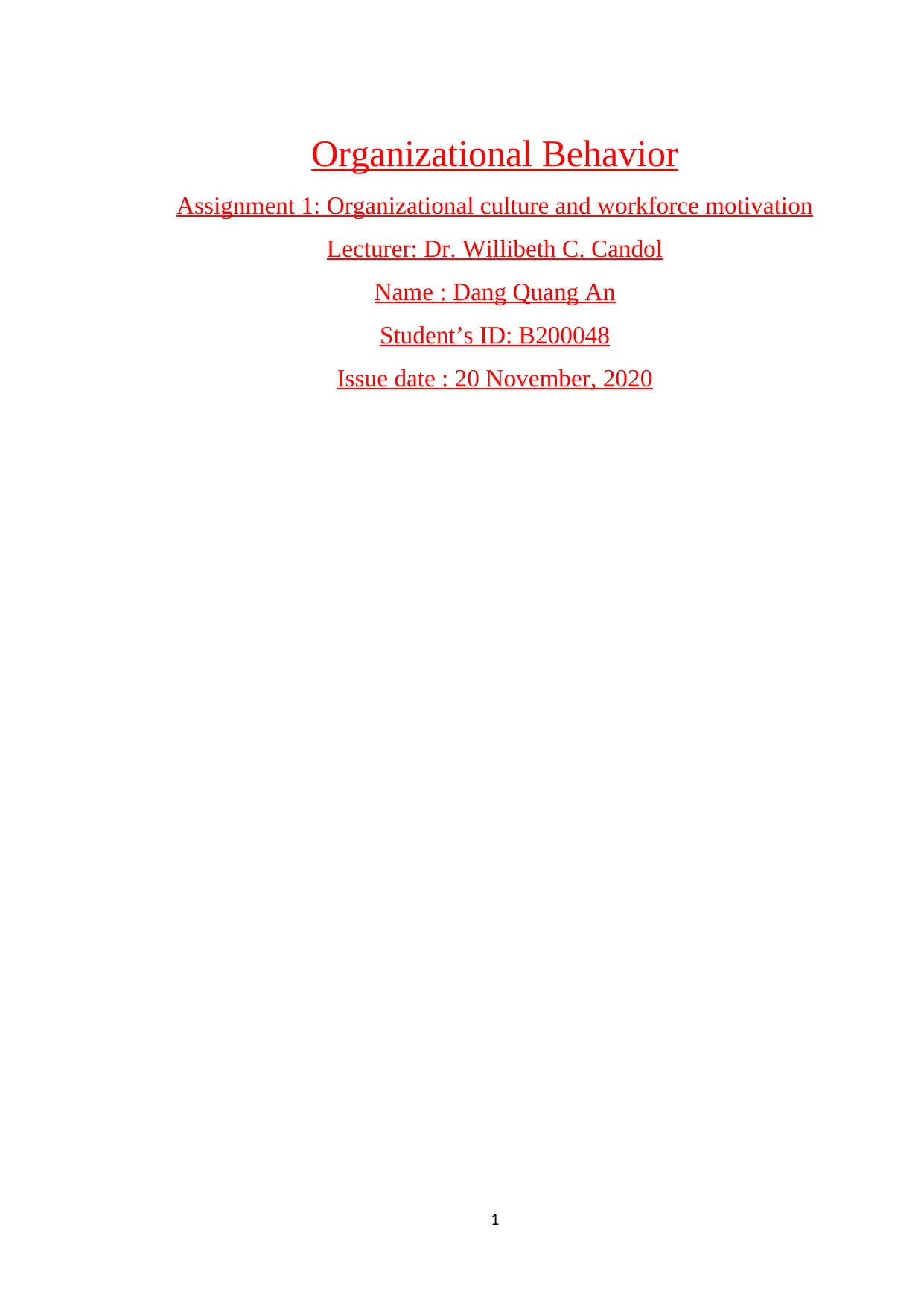
Organizational Behavior
Assignment 1: Organizational culture and workforce motivation
Lecturer: Dr. Willibeth C. Candol
Name : Dang Quang An
Student’s ID: B200048
Issue date : 20 November, 2020
1
Assignment 1: Organizational culture and workforce motivation
Lecturer: Dr. Willibeth C. Candol
Name : Dang Quang An
Student’s ID: B200048
Issue date : 20 November, 2020
1
Paraphrase This Document
Need a fresh take? Get an instant paraphrase of this document with our AI Paraphraser
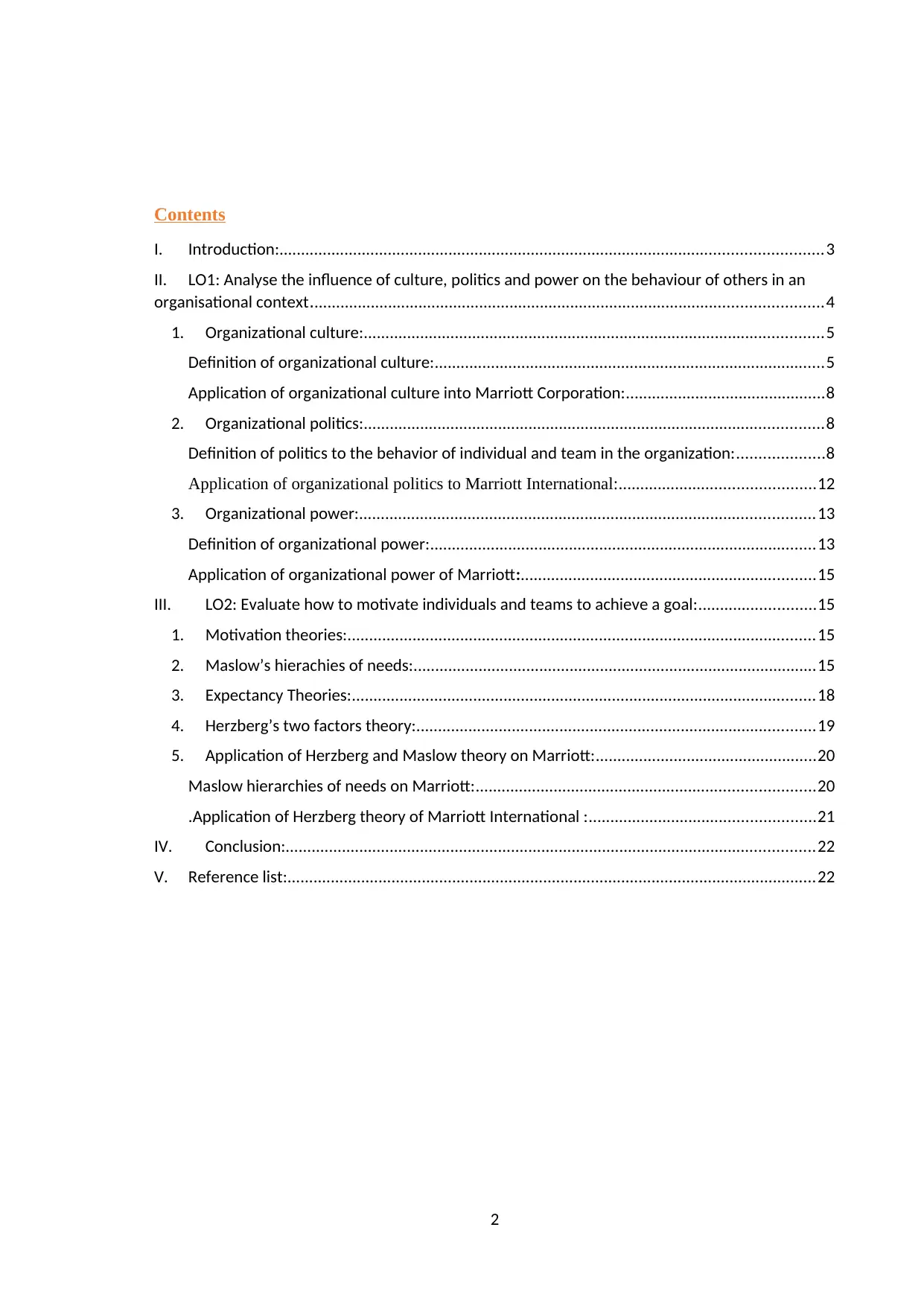
Contents
I. Introduction:.............................................................................................................................3
II. LO1: Analyse the influence of culture, politics and power on the behaviour of others in an
organisational context......................................................................................................................4
1. Organizational culture:..........................................................................................................5
Definition of organizational culture:..........................................................................................5
Application of organizational culture into Marriott Corporation:..............................................8
2. Organizational politics:..........................................................................................................8
Definition of politics to the behavior of individual and team in the organization:....................8
Application of organizational politics to Marriott International:.............................................12
3. Organizational power:.........................................................................................................13
Definition of organizational power:.........................................................................................13
Application of organizational power of Marriott:....................................................................15
III. LO2: Evaluate how to motivate individuals and teams to achieve a goal:...........................15
1. Motivation theories:............................................................................................................15
2. Maslow’s hierachies of needs:.............................................................................................15
3. Expectancy Theories:...........................................................................................................18
4. Herzberg’s two factors theory:............................................................................................19
5. Application of Herzberg and Maslow theory on Marriott:...................................................20
Maslow hierarchies of needs on Marriott:..............................................................................20
.Application of Herzberg theory of Marriott International :....................................................21
IV. Conclusion:..........................................................................................................................22
V. Reference list:..........................................................................................................................22
2
I. Introduction:.............................................................................................................................3
II. LO1: Analyse the influence of culture, politics and power on the behaviour of others in an
organisational context......................................................................................................................4
1. Organizational culture:..........................................................................................................5
Definition of organizational culture:..........................................................................................5
Application of organizational culture into Marriott Corporation:..............................................8
2. Organizational politics:..........................................................................................................8
Definition of politics to the behavior of individual and team in the organization:....................8
Application of organizational politics to Marriott International:.............................................12
3. Organizational power:.........................................................................................................13
Definition of organizational power:.........................................................................................13
Application of organizational power of Marriott:....................................................................15
III. LO2: Evaluate how to motivate individuals and teams to achieve a goal:...........................15
1. Motivation theories:............................................................................................................15
2. Maslow’s hierachies of needs:.............................................................................................15
3. Expectancy Theories:...........................................................................................................18
4. Herzberg’s two factors theory:............................................................................................19
5. Application of Herzberg and Maslow theory on Marriott:...................................................20
Maslow hierarchies of needs on Marriott:..............................................................................20
.Application of Herzberg theory of Marriott International :....................................................21
IV. Conclusion:..........................................................................................................................22
V. Reference list:..........................................................................................................................22
2

I. Introduction:
This assignment will argue about the motivation that an employee need to have in the
workplace and the application of the motivational theories that figures out the most
important role that a company should have to encourage their workers.
Also, the combination of cultural orientation, politics and power contribution will be
involved as specific explanation for how an organization will derive through possessing
productive employees and teams.
3
This assignment will argue about the motivation that an employee need to have in the
workplace and the application of the motivational theories that figures out the most
important role that a company should have to encourage their workers.
Also, the combination of cultural orientation, politics and power contribution will be
involved as specific explanation for how an organization will derive through possessing
productive employees and teams.
3
⊘ This is a preview!⊘
Do you want full access?
Subscribe today to unlock all pages.

Trusted by 1+ million students worldwide
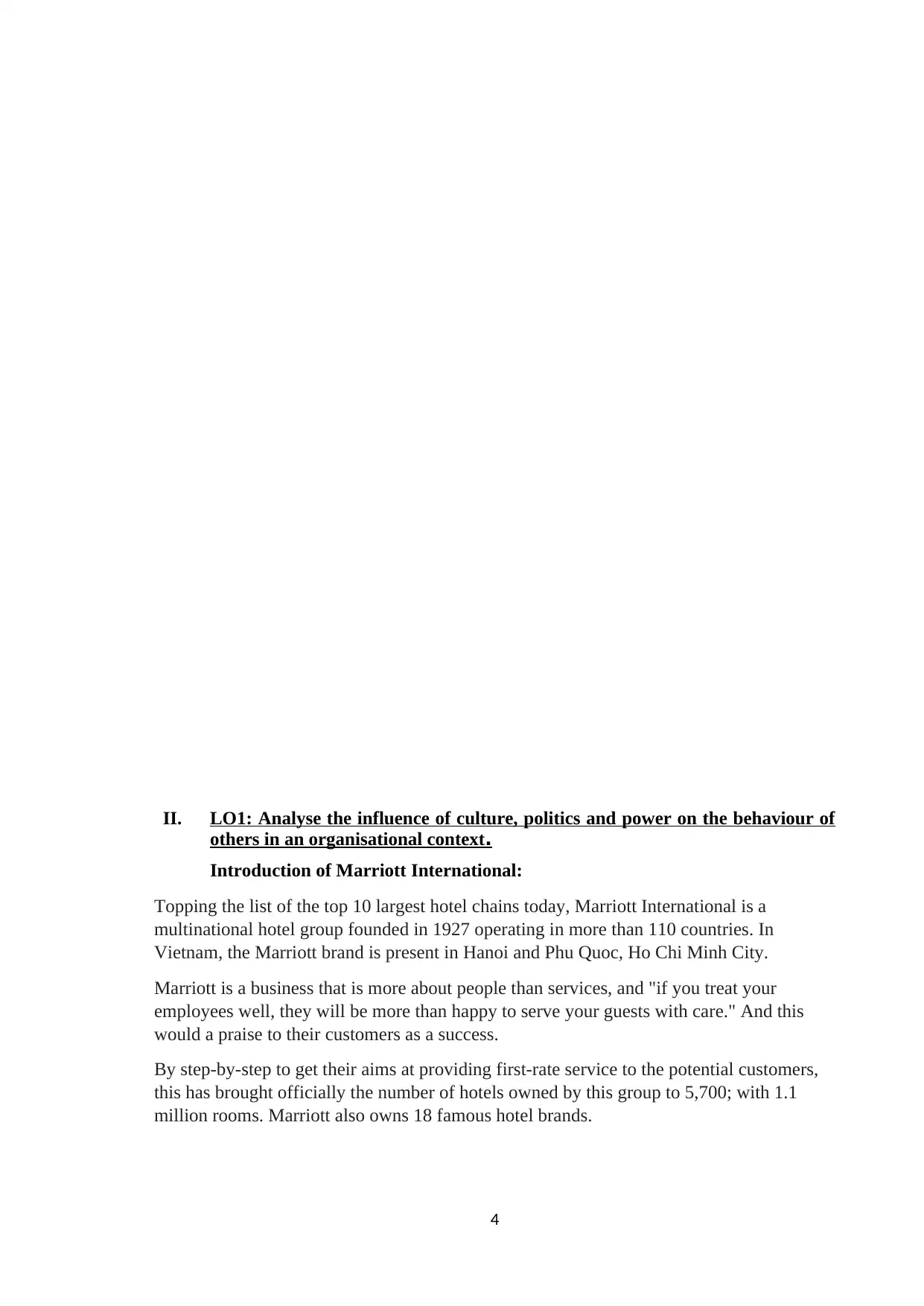
II. LO1: Analyse the influence of culture, politics and power on the behaviour of
others in an organisational context.
Introduction of Marriott International:
Topping the list of the top 10 largest hotel chains today, Marriott International is a
multinational hotel group founded in 1927 operating in more than 110 countries. In
Vietnam, the Marriott brand is present in Hanoi and Phu Quoc, Ho Chi Minh City.
Marriott is a business that is more about people than services, and "if you treat your
employees well, they will be more than happy to serve your guests with care." And this
would a praise to their customers as a success.
By step-by-step to get their aims at providing first-rate service to the potential customers,
this has brought officially the number of hotels owned by this group to 5,700; with 1.1
million rooms. Marriott also owns 18 famous hotel brands.
4
others in an organisational context.
Introduction of Marriott International:
Topping the list of the top 10 largest hotel chains today, Marriott International is a
multinational hotel group founded in 1927 operating in more than 110 countries. In
Vietnam, the Marriott brand is present in Hanoi and Phu Quoc, Ho Chi Minh City.
Marriott is a business that is more about people than services, and "if you treat your
employees well, they will be more than happy to serve your guests with care." And this
would a praise to their customers as a success.
By step-by-step to get their aims at providing first-rate service to the potential customers,
this has brought officially the number of hotels owned by this group to 5,700; with 1.1
million rooms. Marriott also owns 18 famous hotel brands.
4
Paraphrase This Document
Need a fresh take? Get an instant paraphrase of this document with our AI Paraphraser
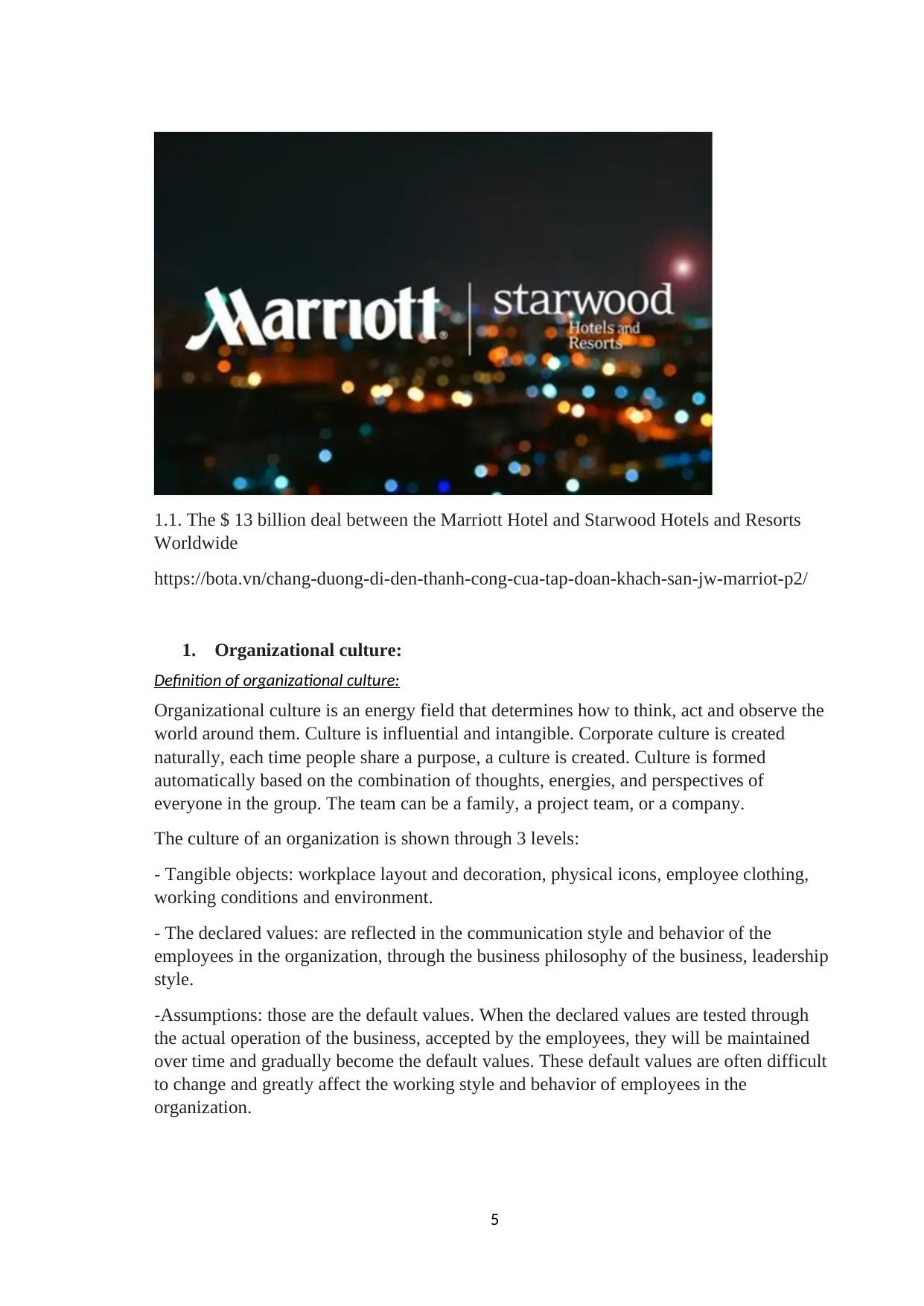
1.1. The $ 13 billion deal between the Marriott Hotel and Starwood Hotels and Resorts
Worldwide
https://bota.vn/chang-duong-di-den-thanh-cong-cua-tap-doan-khach-san-jw-marriot-p2/
1. Organizational culture:
Definition of organizational culture:
Organizational culture is an energy field that determines how to think, act and observe the
world around them. Culture is influential and intangible. Corporate culture is created
naturally, each time people share a purpose, a culture is created. Culture is formed
automatically based on the combination of thoughts, energies, and perspectives of
everyone in the group. The team can be a family, a project team, or a company.
The culture of an organization is shown through 3 levels:
- Tangible objects: workplace layout and decoration, physical icons, employee clothing,
working conditions and environment.
- The declared values: are reflected in the communication style and behavior of the
employees in the organization, through the business philosophy of the business, leadership
style.
-Assumptions: those are the default values. When the declared values are tested through
the actual operation of the business, accepted by the employees, they will be maintained
over time and gradually become the default values. These default values are often difficult
to change and greatly affect the working style and behavior of employees in the
organization.
5
Worldwide
https://bota.vn/chang-duong-di-den-thanh-cong-cua-tap-doan-khach-san-jw-marriot-p2/
1. Organizational culture:
Definition of organizational culture:
Organizational culture is an energy field that determines how to think, act and observe the
world around them. Culture is influential and intangible. Corporate culture is created
naturally, each time people share a purpose, a culture is created. Culture is formed
automatically based on the combination of thoughts, energies, and perspectives of
everyone in the group. The team can be a family, a project team, or a company.
The culture of an organization is shown through 3 levels:
- Tangible objects: workplace layout and decoration, physical icons, employee clothing,
working conditions and environment.
- The declared values: are reflected in the communication style and behavior of the
employees in the organization, through the business philosophy of the business, leadership
style.
-Assumptions: those are the default values. When the declared values are tested through
the actual operation of the business, accepted by the employees, they will be maintained
over time and gradually become the default values. These default values are often difficult
to change and greatly affect the working style and behavior of employees in the
organization.
5

Signs of a great company culture:
Hiring the right people
Having a cultural ambassador
Setting goals
Positive feedback
Rewarding success
Offering pratical perks
Trusting staff
Being flexible
Encouraging open communication
Having an open ear
Hosting social events
Creating a fun workplace
a. The first level : (Artifacts)
6
Hiring the right people
Having a cultural ambassador
Setting goals
Positive feedback
Rewarding success
Offering pratical perks
Trusting staff
Being flexible
Encouraging open communication
Having an open ear
Hosting social events
Creating a fun workplace
a. The first level : (Artifacts)
6
⊘ This is a preview!⊘
Do you want full access?
Subscribe today to unlock all pages.

Trusted by 1+ million students worldwide
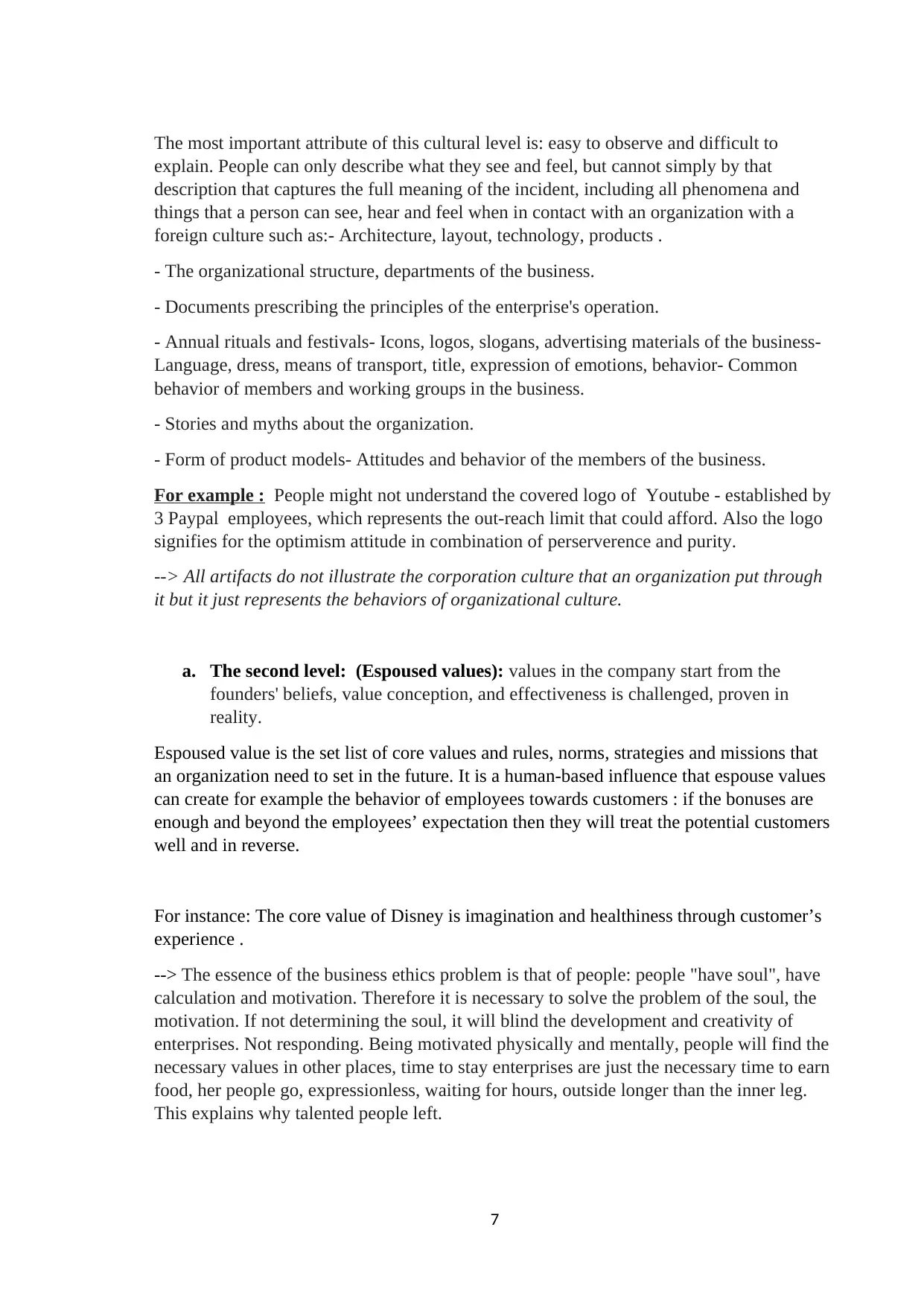
The most important attribute of this cultural level is: easy to observe and difficult to
explain. People can only describe what they see and feel, but cannot simply by that
description that captures the full meaning of the incident, including all phenomena and
things that a person can see, hear and feel when in contact with an organization with a
foreign culture such as:- Architecture, layout, technology, products .
- The organizational structure, departments of the business.
- Documents prescribing the principles of the enterprise's operation.
- Annual rituals and festivals- Icons, logos, slogans, advertising materials of the business-
Language, dress, means of transport, title, expression of emotions, behavior- Common
behavior of members and working groups in the business.
- Stories and myths about the organization.
- Form of product models- Attitudes and behavior of the members of the business.
For example : People might not understand the covered logo of Youtube - established by
3 Paypal employees, which represents the out-reach limit that could afford. Also the logo
signifies for the optimism attitude in combination of perserverence and purity.
--> All artifacts do not illustrate the corporation culture that an organization put through
it but it just represents the behaviors of organizational culture.
a. The second level: (Espoused values): values in the company start from the
founders' beliefs, value conception, and effectiveness is challenged, proven in
reality.
Espoused value is the set list of core values and rules, norms, strategies and missions that
an organization need to set in the future. It is a human-based influence that espouse values
can create for example the behavior of employees towards customers : if the bonuses are
enough and beyond the employees’ expectation then they will treat the potential customers
well and in reverse.
For instance: The core value of Disney is imagination and healthiness through customer’s
experience .
--> The essence of the business ethics problem is that of people: people "have soul", have
calculation and motivation. Therefore it is necessary to solve the problem of the soul, the
motivation. If not determining the soul, it will blind the development and creativity of
enterprises. Not responding. Being motivated physically and mentally, people will find the
necessary values in other places, time to stay enterprises are just the necessary time to earn
food, her people go, expressionless, waiting for hours, outside longer than the inner leg.
This explains why talented people left.
7
explain. People can only describe what they see and feel, but cannot simply by that
description that captures the full meaning of the incident, including all phenomena and
things that a person can see, hear and feel when in contact with an organization with a
foreign culture such as:- Architecture, layout, technology, products .
- The organizational structure, departments of the business.
- Documents prescribing the principles of the enterprise's operation.
- Annual rituals and festivals- Icons, logos, slogans, advertising materials of the business-
Language, dress, means of transport, title, expression of emotions, behavior- Common
behavior of members and working groups in the business.
- Stories and myths about the organization.
- Form of product models- Attitudes and behavior of the members of the business.
For example : People might not understand the covered logo of Youtube - established by
3 Paypal employees, which represents the out-reach limit that could afford. Also the logo
signifies for the optimism attitude in combination of perserverence and purity.
--> All artifacts do not illustrate the corporation culture that an organization put through
it but it just represents the behaviors of organizational culture.
a. The second level: (Espoused values): values in the company start from the
founders' beliefs, value conception, and effectiveness is challenged, proven in
reality.
Espoused value is the set list of core values and rules, norms, strategies and missions that
an organization need to set in the future. It is a human-based influence that espouse values
can create for example the behavior of employees towards customers : if the bonuses are
enough and beyond the employees’ expectation then they will treat the potential customers
well and in reverse.
For instance: The core value of Disney is imagination and healthiness through customer’s
experience .
--> The essence of the business ethics problem is that of people: people "have soul", have
calculation and motivation. Therefore it is necessary to solve the problem of the soul, the
motivation. If not determining the soul, it will blind the development and creativity of
enterprises. Not responding. Being motivated physically and mentally, people will find the
necessary values in other places, time to stay enterprises are just the necessary time to earn
food, her people go, expressionless, waiting for hours, outside longer than the inner leg.
This explains why talented people left.
7
Paraphrase This Document
Need a fresh take? Get an instant paraphrase of this document with our AI Paraphraser
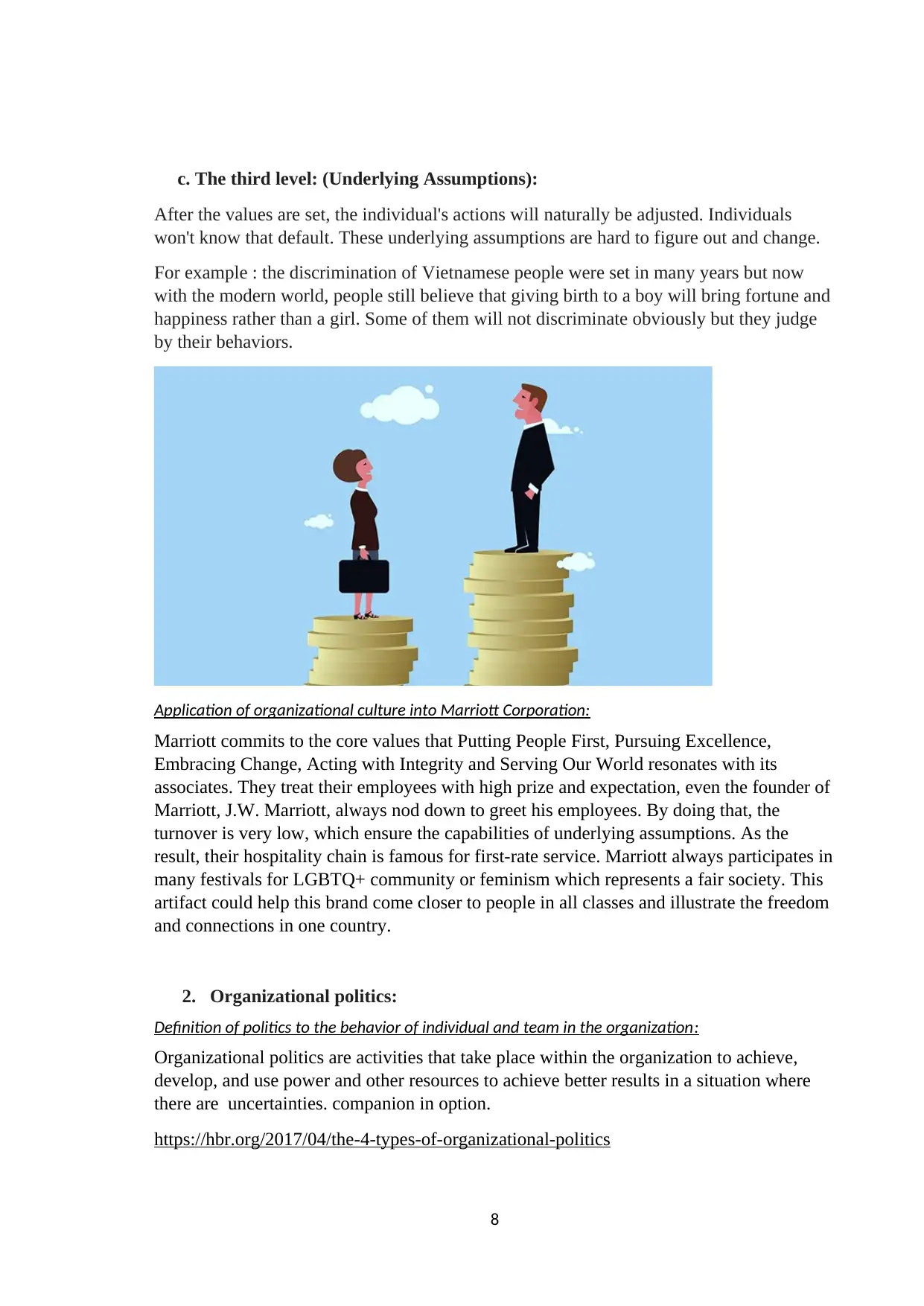
c. The third level: (Underlying Assumptions):
After the values are set, the individual's actions will naturally be adjusted. Individuals
won't know that default. These underlying assumptions are hard to figure out and change.
For example : the discrimination of Vietnamese people were set in many years but now
with the modern world, people still believe that giving birth to a boy will bring fortune and
happiness rather than a girl. Some of them will not discriminate obviously but they judge
by their behaviors.
Application of organizational culture into Marriott Corporation:
Marriott commits to the core values that Putting People First, Pursuing Excellence,
Embracing Change, Acting with Integrity and Serving Our World resonates with its
associates. They treat their employees with high prize and expectation, even the founder of
Marriott, J.W. Marriott, always nod down to greet his employees. By doing that, the
turnover is very low, which ensure the capabilities of underlying assumptions. As the
result, their hospitality chain is famous for first-rate service. Marriott always participates in
many festivals for LGBTQ+ community or feminism which represents a fair society. This
artifact could help this brand come closer to people in all classes and illustrate the freedom
and connections in one country.
2. Organizational politics:
Definition of politics to the behavior of individual and team in the organization:
Organizational politics are activities that take place within the organization to achieve,
develop, and use power and other resources to achieve better results in a situation where
there are uncertainties. companion in option.
https://hbr.org/2017/04/the-4-types-of-organizational-politics
8
After the values are set, the individual's actions will naturally be adjusted. Individuals
won't know that default. These underlying assumptions are hard to figure out and change.
For example : the discrimination of Vietnamese people were set in many years but now
with the modern world, people still believe that giving birth to a boy will bring fortune and
happiness rather than a girl. Some of them will not discriminate obviously but they judge
by their behaviors.
Application of organizational culture into Marriott Corporation:
Marriott commits to the core values that Putting People First, Pursuing Excellence,
Embracing Change, Acting with Integrity and Serving Our World resonates with its
associates. They treat their employees with high prize and expectation, even the founder of
Marriott, J.W. Marriott, always nod down to greet his employees. By doing that, the
turnover is very low, which ensure the capabilities of underlying assumptions. As the
result, their hospitality chain is famous for first-rate service. Marriott always participates in
many festivals for LGBTQ+ community or feminism which represents a fair society. This
artifact could help this brand come closer to people in all classes and illustrate the freedom
and connections in one country.
2. Organizational politics:
Definition of politics to the behavior of individual and team in the organization:
Organizational politics are activities that take place within the organization to achieve,
develop, and use power and other resources to achieve better results in a situation where
there are uncertainties. companion in option.
https://hbr.org/2017/04/the-4-types-of-organizational-politics
8
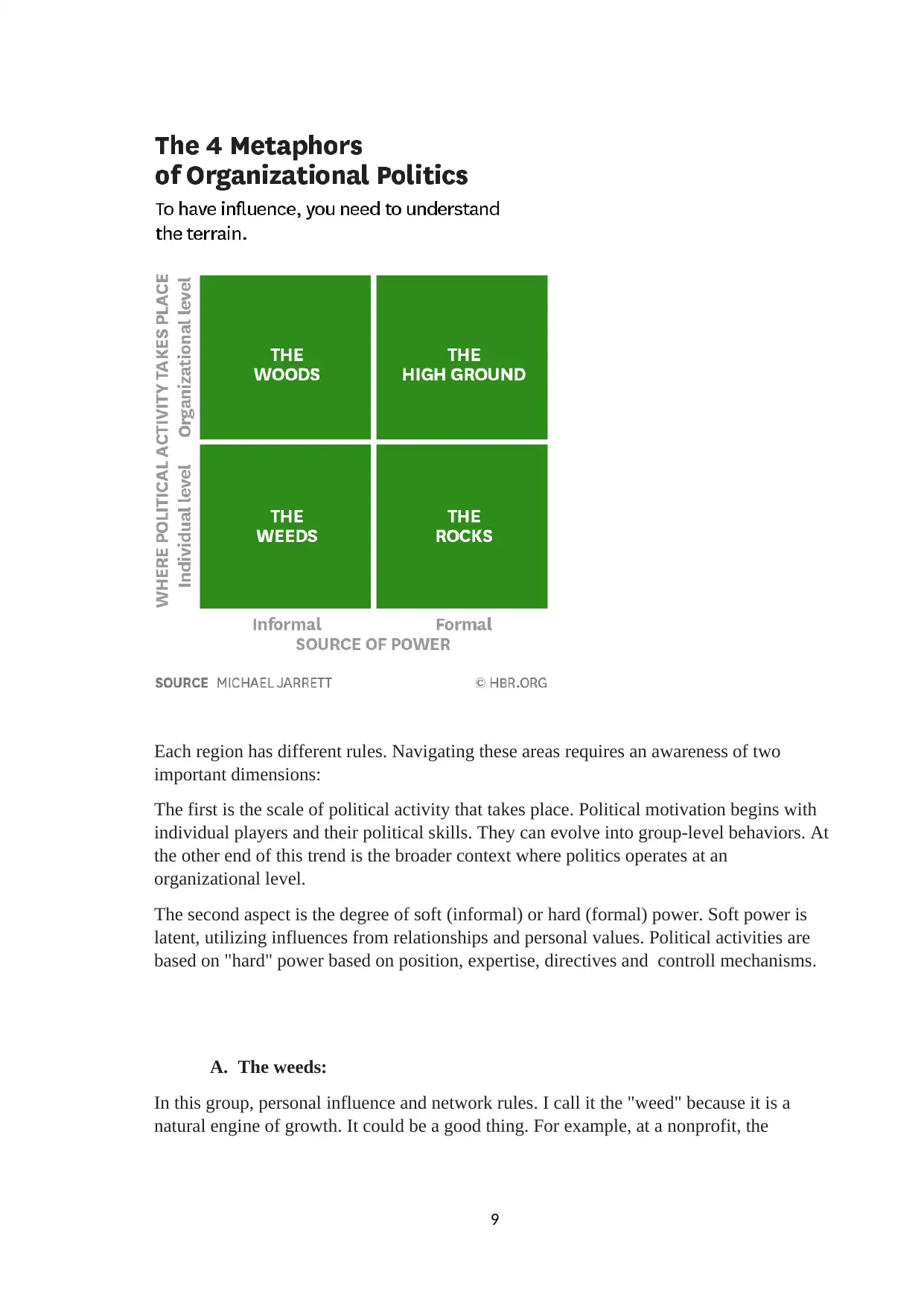
Each region has different rules. Navigating these areas requires an awareness of two
important dimensions:
The first is the scale of political activity that takes place. Political motivation begins with
individual players and their political skills. They can evolve into group-level behaviors. At
the other end of this trend is the broader context where politics operates at an
organizational level.
The second aspect is the degree of soft (informal) or hard (formal) power. Soft power is
latent, utilizing influences from relationships and personal values. Political activities are
based on "hard" power based on position, expertise, directives and controll mechanisms.
A. The weeds:
In this group, personal influence and network rules. I call it the "weed" because it is a
natural engine of growth. It could be a good thing. For example, at a nonprofit, the
9
important dimensions:
The first is the scale of political activity that takes place. Political motivation begins with
individual players and their political skills. They can evolve into group-level behaviors. At
the other end of this trend is the broader context where politics operates at an
organizational level.
The second aspect is the degree of soft (informal) or hard (formal) power. Soft power is
latent, utilizing influences from relationships and personal values. Political activities are
based on "hard" power based on position, expertise, directives and controll mechanisms.
A. The weeds:
In this group, personal influence and network rules. I call it the "weed" because it is a
natural engine of growth. It could be a good thing. For example, at a nonprofit, the
9
⊘ This is a preview!⊘
Do you want full access?
Subscribe today to unlock all pages.

Trusted by 1+ million students worldwide

Secretary-General took an action (sometimes seen as unethical), causing employees to
worry that they would lose sponsor support and government officials. As a result, an
informal group met regularly to cover up their bad situations. However, within a year, this
got him out of trouble to protect the reputation of the organization. As such, the
development of an informal alliance with political activity is, in this case, a force for good.
To manage the weeds, by fully understanding about the informal network, if the weeds are
supportive of a change, we can provide a network of change champions with the
appropriate support, knowledge and skills to be effective in long-term. This could help
manage the inevitable ambiguity and certainty that comes with change. They can be a real
advantage in embedding and sustaining change within the organization.
B. The rocks:
Power in "Rock" regions is based on personal interactions and "hard" powers (power of
position, expertise or the ability to access resources). It can also include political capital
arising from members or strong relationships with a high-profile group such as the finance
department, a task force, or senior management team. I call this the "rock" because the
rock can symbolize a strong foundation for keeping an organization stable in times of
crisis. But on the contrary, the sharp edges of hard strength can stagnate and ruin
development plans.
Jesse Jacoby in ‘Strategies for Managing Resistance to Change’ suggests:
‘This can be done by allowing change resistors to veto elements of change that are
threatening, or change resistors can be offered incentives to go elsewhere in the company
in order to avoid having to experience the change effort’.
For example, in the case of an advertising agency, senior executives have used the
argument of "potential negative legacy" to the Chairman to review how he is undermining
the long-term interests of the company. . In fact, it is this political act and misuse of power
that motivated Max Weber, a sociologist, to write the book Bureaucracy, where he argues
that the bureaucracy is the most plausible and best way to organize, cooperate and
coordinate modern corporations. This leads us to grow taller.
C. The high ground:
The high ground combines formal authority with organizational systems; I use the term to
describe the rules, structures, policy guidelines, and procedures that form the basis of
political activities.
Therefore, the "high ground" provides guidance to the "Rock" area. It is a political
function. The process of using the structures of control systems and sanctions that help the
organization comply. However, as many regulators know, rules and procedures can also
lead to companies becoming too bureaucratic, where rules are used as a political device to
challenge concerns. appropriate or prevent organizational innovation and change.
10
worry that they would lose sponsor support and government officials. As a result, an
informal group met regularly to cover up their bad situations. However, within a year, this
got him out of trouble to protect the reputation of the organization. As such, the
development of an informal alliance with political activity is, in this case, a force for good.
To manage the weeds, by fully understanding about the informal network, if the weeds are
supportive of a change, we can provide a network of change champions with the
appropriate support, knowledge and skills to be effective in long-term. This could help
manage the inevitable ambiguity and certainty that comes with change. They can be a real
advantage in embedding and sustaining change within the organization.
B. The rocks:
Power in "Rock" regions is based on personal interactions and "hard" powers (power of
position, expertise or the ability to access resources). It can also include political capital
arising from members or strong relationships with a high-profile group such as the finance
department, a task force, or senior management team. I call this the "rock" because the
rock can symbolize a strong foundation for keeping an organization stable in times of
crisis. But on the contrary, the sharp edges of hard strength can stagnate and ruin
development plans.
Jesse Jacoby in ‘Strategies for Managing Resistance to Change’ suggests:
‘This can be done by allowing change resistors to veto elements of change that are
threatening, or change resistors can be offered incentives to go elsewhere in the company
in order to avoid having to experience the change effort’.
For example, in the case of an advertising agency, senior executives have used the
argument of "potential negative legacy" to the Chairman to review how he is undermining
the long-term interests of the company. . In fact, it is this political act and misuse of power
that motivated Max Weber, a sociologist, to write the book Bureaucracy, where he argues
that the bureaucracy is the most plausible and best way to organize, cooperate and
coordinate modern corporations. This leads us to grow taller.
C. The high ground:
The high ground combines formal authority with organizational systems; I use the term to
describe the rules, structures, policy guidelines, and procedures that form the basis of
political activities.
Therefore, the "high ground" provides guidance to the "Rock" area. It is a political
function. The process of using the structures of control systems and sanctions that help the
organization comply. However, as many regulators know, rules and procedures can also
lead to companies becoming too bureaucratic, where rules are used as a political device to
challenge concerns. appropriate or prevent organizational innovation and change.
10
Paraphrase This Document
Need a fresh take? Get an instant paraphrase of this document with our AI Paraphraser
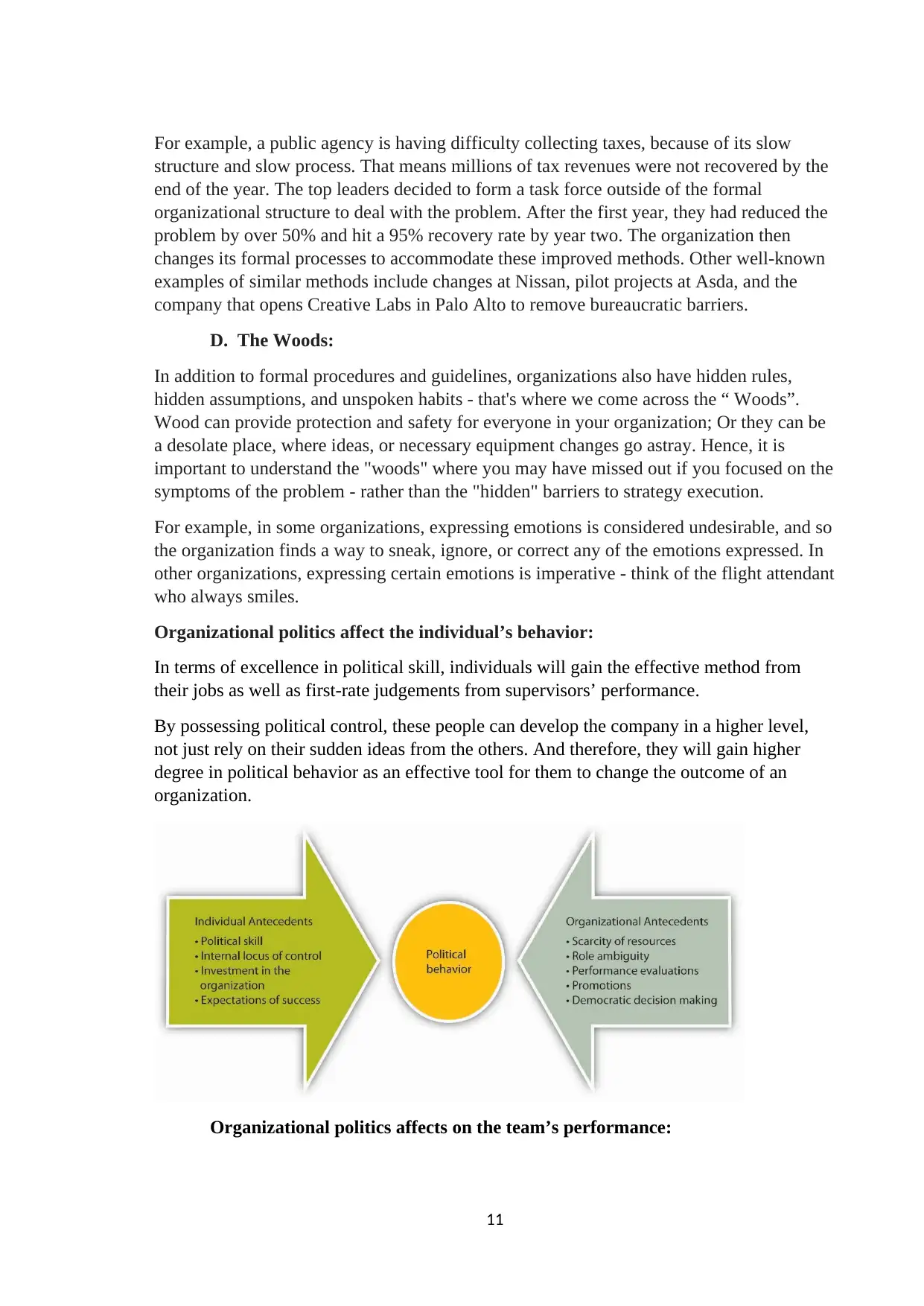
For example, a public agency is having difficulty collecting taxes, because of its slow
structure and slow process. That means millions of tax revenues were not recovered by the
end of the year. The top leaders decided to form a task force outside of the formal
organizational structure to deal with the problem. After the first year, they had reduced the
problem by over 50% and hit a 95% recovery rate by year two. The organization then
changes its formal processes to accommodate these improved methods. Other well-known
examples of similar methods include changes at Nissan, pilot projects at Asda, and the
company that opens Creative Labs in Palo Alto to remove bureaucratic barriers.
D. The Woods:
In addition to formal procedures and guidelines, organizations also have hidden rules,
hidden assumptions, and unspoken habits - that's where we come across the “ Woods”.
Wood can provide protection and safety for everyone in your organization; Or they can be
a desolate place, where ideas, or necessary equipment changes go astray. Hence, it is
important to understand the "woods" where you may have missed out if you focused on the
symptoms of the problem - rather than the "hidden" barriers to strategy execution.
For example, in some organizations, expressing emotions is considered undesirable, and so
the organization finds a way to sneak, ignore, or correct any of the emotions expressed. In
other organizations, expressing certain emotions is imperative - think of the flight attendant
who always smiles.
Organizational politics affect the individual’s behavior:
In terms of excellence in political skill, individuals will gain the effective method from
their jobs as well as first-rate judgements from supervisors’ performance.
By possessing political control, these people can develop the company in a higher level,
not just rely on their sudden ideas from the others. And therefore, they will gain higher
degree in political behavior as an effective tool for them to change the outcome of an
organization.
Organizational politics affects on the team’s performance:
11
structure and slow process. That means millions of tax revenues were not recovered by the
end of the year. The top leaders decided to form a task force outside of the formal
organizational structure to deal with the problem. After the first year, they had reduced the
problem by over 50% and hit a 95% recovery rate by year two. The organization then
changes its formal processes to accommodate these improved methods. Other well-known
examples of similar methods include changes at Nissan, pilot projects at Asda, and the
company that opens Creative Labs in Palo Alto to remove bureaucratic barriers.
D. The Woods:
In addition to formal procedures and guidelines, organizations also have hidden rules,
hidden assumptions, and unspoken habits - that's where we come across the “ Woods”.
Wood can provide protection and safety for everyone in your organization; Or they can be
a desolate place, where ideas, or necessary equipment changes go astray. Hence, it is
important to understand the "woods" where you may have missed out if you focused on the
symptoms of the problem - rather than the "hidden" barriers to strategy execution.
For example, in some organizations, expressing emotions is considered undesirable, and so
the organization finds a way to sneak, ignore, or correct any of the emotions expressed. In
other organizations, expressing certain emotions is imperative - think of the flight attendant
who always smiles.
Organizational politics affect the individual’s behavior:
In terms of excellence in political skill, individuals will gain the effective method from
their jobs as well as first-rate judgements from supervisors’ performance.
By possessing political control, these people can develop the company in a higher level,
not just rely on their sudden ideas from the others. And therefore, they will gain higher
degree in political behavior as an effective tool for them to change the outcome of an
organization.
Organizational politics affects on the team’s performance:
11
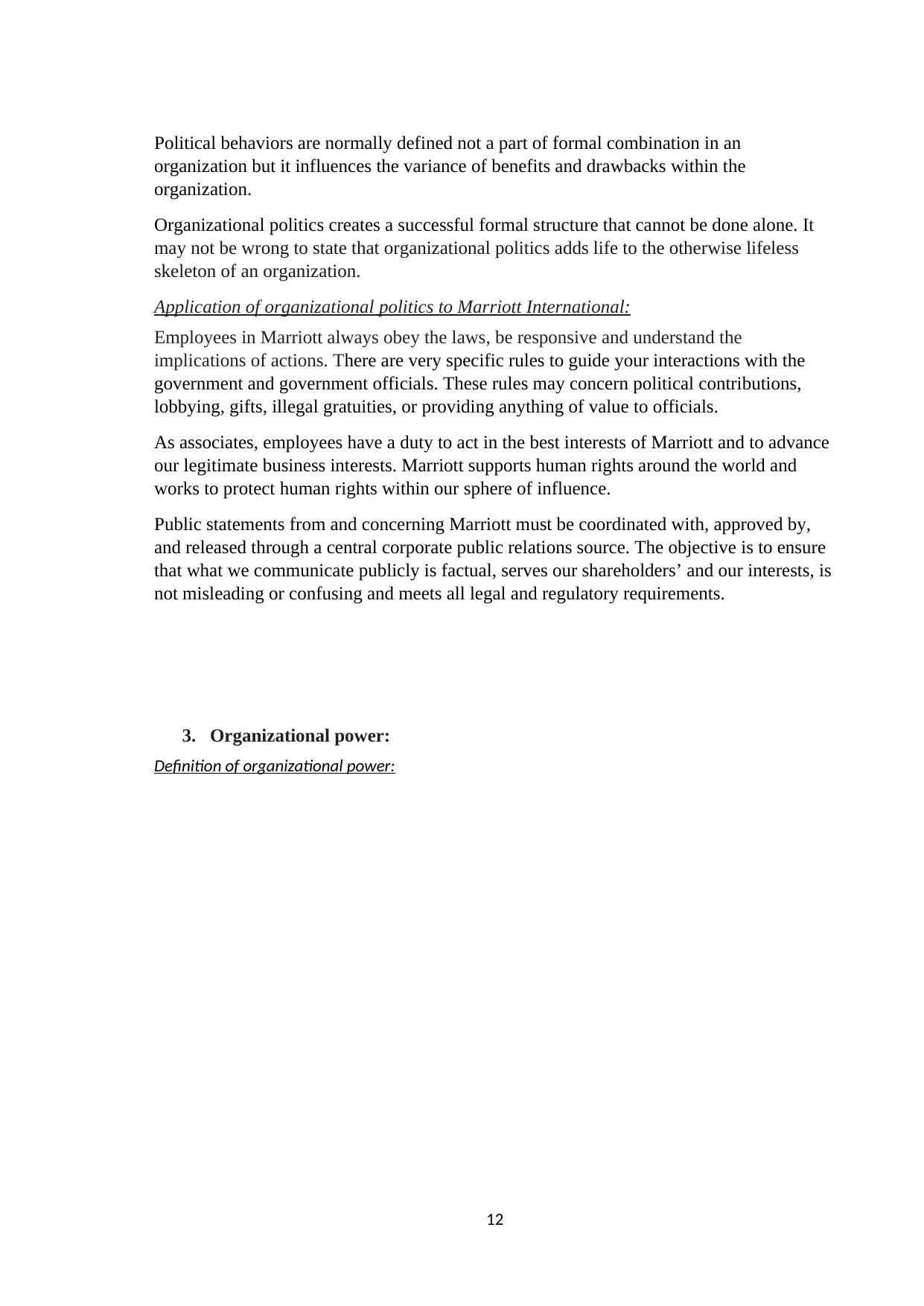
Political behaviors are normally defined not a part of formal combination in an
organization but it influences the variance of benefits and drawbacks within the
organization.
Organizational politics creates a successful formal structure that cannot be done alone. It
may not be wrong to state that organizational politics adds life to the otherwise lifeless
skeleton of an organization.
Application of organizational politics to Marriott International:
Employees in Marriott always obey the laws, be responsive and understand the
implications of actions. There are very specific rules to guide your interactions with the
government and government officials. These rules may concern political contributions,
lobbying, gifts, illegal gratuities, or providing anything of value to officials.
As associates, employees have a duty to act in the best interests of Marriott and to advance
our legitimate business interests. Marriott supports human rights around the world and
works to protect human rights within our sphere of influence.
Public statements from and concerning Marriott must be coordinated with, approved by,
and released through a central corporate public relations source. The objective is to ensure
that what we communicate publicly is factual, serves our shareholders’ and our interests, is
not misleading or confusing and meets all legal and regulatory requirements.
3. Organizational power:
Definition of organizational power:
12
organization but it influences the variance of benefits and drawbacks within the
organization.
Organizational politics creates a successful formal structure that cannot be done alone. It
may not be wrong to state that organizational politics adds life to the otherwise lifeless
skeleton of an organization.
Application of organizational politics to Marriott International:
Employees in Marriott always obey the laws, be responsive and understand the
implications of actions. There are very specific rules to guide your interactions with the
government and government officials. These rules may concern political contributions,
lobbying, gifts, illegal gratuities, or providing anything of value to officials.
As associates, employees have a duty to act in the best interests of Marriott and to advance
our legitimate business interests. Marriott supports human rights around the world and
works to protect human rights within our sphere of influence.
Public statements from and concerning Marriott must be coordinated with, approved by,
and released through a central corporate public relations source. The objective is to ensure
that what we communicate publicly is factual, serves our shareholders’ and our interests, is
not misleading or confusing and meets all legal and regulatory requirements.
3. Organizational power:
Definition of organizational power:
12
⊘ This is a preview!⊘
Do you want full access?
Subscribe today to unlock all pages.

Trusted by 1+ million students worldwide
1 out of 23
Related Documents
Your All-in-One AI-Powered Toolkit for Academic Success.
+13062052269
info@desklib.com
Available 24*7 on WhatsApp / Email
![[object Object]](/_next/static/media/star-bottom.7253800d.svg)
Unlock your academic potential
Copyright © 2020–2025 A2Z Services. All Rights Reserved. Developed and managed by ZUCOL.


